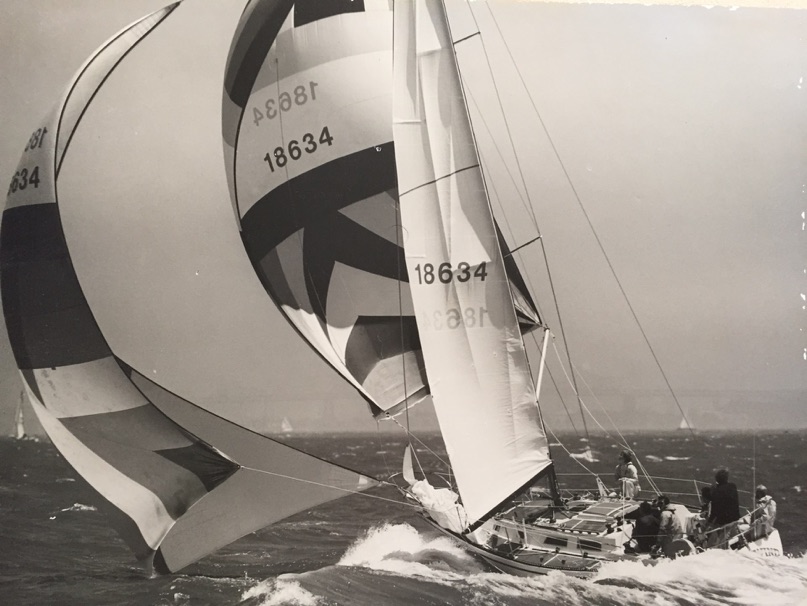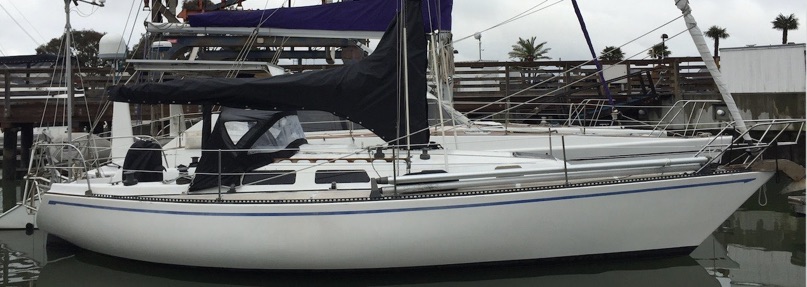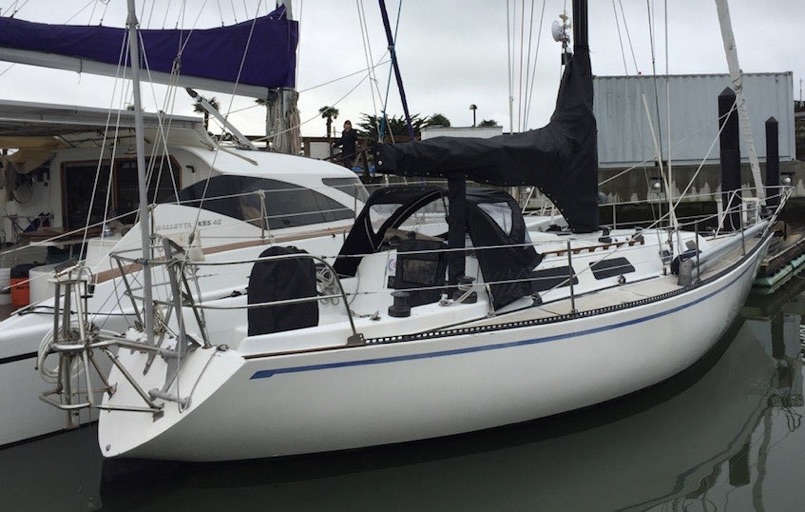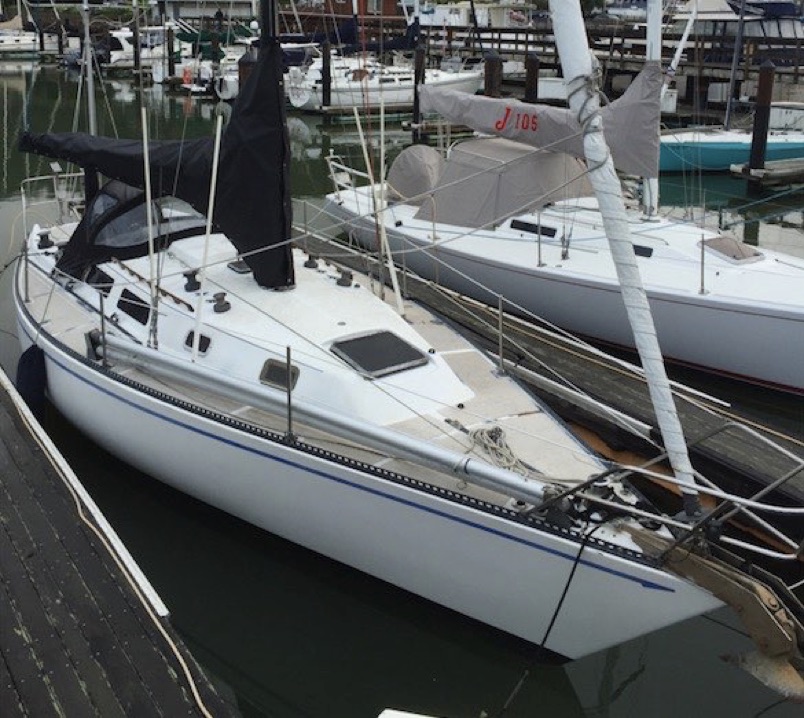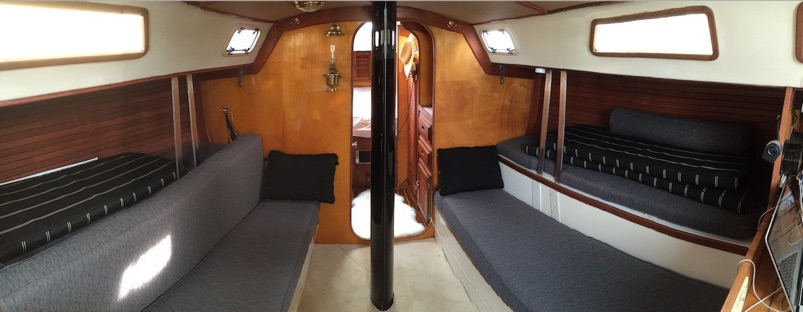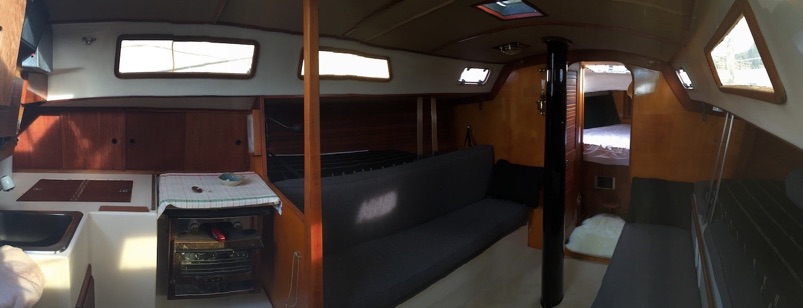“Go sailing now my friend,
it is later than you think”


“Go sailing now my friend,
it is later than you think”


This magnificent yacht is for sale - - $29,900
Magewind has a wonderful past, from being a first place race yacht to completing many passages up and down the coast and several trips to Mexico.

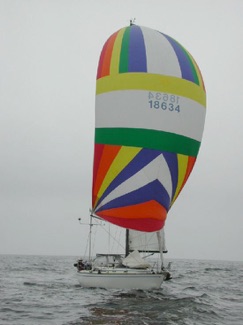
1977, Peterson 34 sailing yacht MAGEWIND
Peterson 34
This fast, tough racer-cruiser is well suited for offshore racing
American yacht designer Doug Peterson gained the attention of the world’s most competitive sailors when he unveiled the one tonner Ganbare in 1973. The 35-foot sloop was innovative below the waterline, and it was praised for its looks and sailing capability. It went on to win the SORC. By 1976, Peterson had designed the Peterson 34, an offshore racer-cruiser.
The Peterson 34 went into production at Texas-based Island Yachts/Composite Technologies, and 92 were built until production ceased in 1981. Composite Technologies, established by boatbuilder Andy Green in Corpus Christi, Texas, was acquired sometime around 1976 by boatbuilder and rigger Marion Hayes. Hayes renamed the company Island Yacht Corp. and relocated production to League City, Texas.
It was during this era that Peterson’s designs dominated offshore racing, with winning IOR boats Gumboots, Eclipse, and Ragamuffin. He also designed several stock racers such as the Contessa 35 and the New York 40.
The majority of Peterson’s performance cruisers were considered rugged enough for ocean racing. Peterson once said the 34 “was built to deliver about eight people quickly and safely from point A to point B.”
First impressions:
The Peterson 34 is as fast as it looks, and this quality solidified Peterson’s reputation as a designer. The sloop’s profile from abeam is sleek, the sharp cut bow and reverse transom give the boat a sense of forward motion.
The dimensions are well proportioned—the 11-foot 2-inch beam is just about one-third of the boat’s 33-foot 11-inch overall length. The smooth, rounded deck contour is clearly designed to shed seawater. The compact cockpit, with its oceangoing bridgedeck, allows room for a tiller but little else. The traveler is mounted across the bridgedeck. Trimmers can easily reach the primary and secondary winches, none of which were originally self-tailing.
This fast, tough racer-cruiser is well suited for offshore racing
Construction:
The hulls are hand-laid fiberglass mat and unidirectional roving with polyester resin. Although the hulls might be considered thick by today’s standards, the materials were both lightweight and strong for the late 1970s. Early reviews of the Peterson 34 referred to the use of Kevlar, particularly at the maststep and other stress points, but there is no indication that the then-new synthetic was added.
As one owner put it, the Peterson 34 has an extremely strong build and no emergent structural problems, “but they are no Swans cosmetically.” Owners have commented about its shortcomings related mostly to the interior joinery and cabin finish.
What to look for:
As the number of Peterson 34s grew on the water, races revealed skippers could get more out of the boat by welding an extension to lengthen the boom. The original boom was just over 11 feet long and some were modified until they nearly touched the backstay.
Potential buyers might also encounter a steering wheel instead of a tiller, a replacement that has caused plenty of debate. A destroyer wheel could make the cockpit more cramped and difficult for crew to work the winches. Owners have also questioned how big a wheel would be needed to deliver the same amount of leverage provided by a tiller. Those who swear by a tiller celebrate its minimum of moving parts compared to a more complex wheel. Concern has also been expressed that any cockpit reinforcement required before installing a wheel, added to the weight of a pedestal and helmsman aft, could upset the boat’s fine balance. Advocates of replacement, which costs about $3,000, say it makes it easier to steer and to connect an autopilot. As a general rule, a Peterson 34 with a wheel probably was not campaigned as a race boat.
At nearly 40 years old, any original standing rigging, turnbuckles or lifelines are likely rusted or weakened. These should be replaced. Check the rudder post for wear. Examine portals and chainplates for leakage.
On deck:
The Peterson 34’s double-spreader mast is stepped on the keel. The sailplan features a high-aspect main and massive foretriangle, both common design features in the 1970s. These characteristics were often influenced by IOR rules and can take a bit of muscle to control.
Four winches flank the cockpit to control the sheets. The winches are bolted to the coamings. Additional winches are located atop the coachroof.
The small cockpit has two drains. The toerail track provides plenty of locations to attach sheet blocks for efficient sail trim. Potential buyers should check for soft spots on deck and stress at the stanchions.
Down below:
Below deck the Peterson 34 is comfortable but certainly not luxurious or spacious. Once down the companionway there’s a compact galley with sink, stove and icebox to port. An efficient navigation station with seat is located to starboard. The saloon is essentially a settee and pilotberth on either side and a teak dining table. The enclosed head with a sink is to port and does not have a wastewater tank unless one was later installed. A stowage cubby and hanging locker to starboard is directly across from the head. The V-berth sleeps two but is often used for sail stowage when only four sailors are aboard. The engine box is beneath the companionway. The boat carries 18 gallons of water.
Engine:
The Peterson 34 has auxiliary power supplied by a 15-horsepower, raw-water-cooled Yanmar 2QM15G diesel engine. Examine the belts and hoses for wear. Check fluid levels and filters. If possible, shine a light on the engine mounts to look for cracking or loose bolts. The boat has a 12-gallon fuel tank.
Underway:
Ask pretty much any owner and you’ll hear the Peterson 34 is one sweet boat under sail.
“It sails like a dinghy,” said owner John Mills of Mattapoisett, Massachusetts. “The tiller makes it very responsive.”
Certainly the combination of spade rudder, fin keel and substantial ballast give the boat both speed and handling ability. Owners have noted the design had less of a pintail than the pure IOR designs of the day, making it “less squirrely” when running downwind in a breeze.
The Peterson 34 is known for its upwind sailing ability. It can point high in light and heavy air, but sail changes will be necessary as wind speed increases due to the relatively large foresails that were typical of that era.
“It has a reputation as a boat that’s good in light air,” said yacht broker John Proctor at Lawson Yachts. “It’s attractive, well designed and can keep a crew of five comfortable.”
Owners report the boat does not pound because the fine bow shape slices through the waves, yet can be troublesome to handle under spinnaker in heavy weather should the bow dig and cause the boat to broach.
Conclusion:
Fast, tough and well built, the Peterson 34 is an affordable performance cruiser capable of safely passaging whether on a weeklong cruise or as a contender in an offshore race.
LOA 33’11”
LWL 28’3”
Beam 11’2”
Draft 6’4”
Displ. 10,800 lbs.
Ballast 5,100 lbs.
Sail Area 339 sq. ft.
General Market Price Data:
$15,000
1978 Massachusetts
$27,000
1978 Wisconsin
$35,000
1979 Montana
Vessel particulars
Name: MAGEWIND
Home Port: Sausalito, CA
HIN: CTE340241177
Builder: Island Yacht Corp. P.O. Box 891, League City, TX 77573. Year Built: 1977
Length: 33 feet 11 inches
Beam: 11 feet 2 inches
Draft: 6 feet 3 inches
Displacement: 10,800 lbs.
Construction: Fiber Reinforced Plastic (FRP)
Propulsion: Yanmar Model 3GM30F Serial Numbers 16576
Fuel: Diesel
Horsepower: 30 hp. / 20.1 kW.
Construction Details
Hull and Deck: The hull was constructed of cored FRP with internal FRP framing bonded to the hull. . The ballast is exterior bolted to the FRP hull. The hull was a fin keel, spade rudder design. The hull to deck joint was an inward turned flange with through bolted toe rail. The main deck was cored FRP construction with tread master nonskid.
Hatches and Doors: There was an aluminum and Plexiglas hatch on the forward end of the deck house providing access to the forward vee berth space. There was a small ventilation hatch aft of the mast of similar construction. The companionway hatch was located amidships on a bridge deck. There were drop boards and a sliding cover to close this hatch. The cockpit contained hatches in the cockpit seats port and aft giving access into the steering compartment and a large locker.
Windows: There were four opening port lights in the cabin house. They were upgrades from the original plastic port lights. There were four fixed windows in the cabin house.
Through Hull Fittings: There were six through hull fittings below the waterline. Each had a proper bronze valve which operated satisfactorily. Below the galley sink there were three ball valves; one for galley sink drain, one for engine cooling water intake and one which combined salt water for the sink, cooling water for the refrigerator compressor and salt water for the water maker. There was a single gate valve under the port settee berth for salt water wash down. There were two valves just forward of the head to port for flushing water intake (gate valve) and MSD discharge (ball valve). There were four through hull fittings in the topsides above the waterline. The two cockpit drains port and starboard exited under the transom with solid FRP pipes attaching the cockpit to the hull; There was the main engine exhaust under the counter of the transom and the manual bilge pump discharge. The speed log was of the paddle wheel type installed on center forward of the keel. There were three depth sounder transducers in the forward portion of the hull.
Fire Fighting Equipment
Fixed systems: Portable Extinguishers: There were two portable size B-I fire extinguishers on board in proper mounting brackets. They were of the pressure type and showed proper charge and were in good, serviceable condition. The equipment on board met the minimum number to comply with the federal and state standards.
Bilge pumping systems
There was one manual bilge pump installed on board with the suction in the bilge sump.
Propulsion systems
General: The auxiliary engine was replaced in 1996 with a Yanmar model 3GM30F, Serial Numbers 16676. The engine warning lights were located in the starboard aft side of the cockpit. There was an engine hour meter which showed 1509 hours on the new engine. Oil change has an installed hose and pump.
The main engine was fresh water cooled via a sea water heat exchanger.
The exhaust system was a wet exhaust with a water lift muffler.
PSS (Packless Sealing System) Shaft Seals
Three blade prop
35 gallon capacity aluminum fuel tank located under the port settee berth. The fuel fill for the tanks was located on the port side main deck amidships with proper deck fitting. A vent line to the exterior of the vessel through the port life line station through a Racor Lifeguard 3-Stage Fuel / Air Separator.
There is Racor fuel filter plumbed in the fuel line, from the tank to the engine.
Steering Systems
Main steering system: The vessel was steered with a chain and cable wheel pedestal steering system. The top of the rudder post extends into the cockpit for installation of an emergency tiller. The emergency tiller is in the starboard forward hanging locker opposite the head. There was also an Autohelm 7000 underdeck mounted autopilot installed attached to the radial quadrant. This system is oversized and well installed. The large steering wheel had a leather cover with crown knot.
The vessel had a spade rudder.
Electrical Systems
Primary power and lighting systems: The primary power and lighting system was a 12 volt DC system supplied by one battery for engine start and household services. The vessel's secondary electrical system was a 120 volt AC system powered by shore power.
Distribution switchboards & panel boards; over current protection: The AC and DC electrical systems were in excellent condition. The distribution panel was located outboard of the chart table.
Wiring, receptacles, outlets and accessories: The 120 VAC outlets were on GFI circuits.
Shore power connection: The vessel had a proper 30 amp. marine shore power hook-up located in the cockpit coaming to starboard.
Main engine powered generators: The main engine has a 30 amp alternator installed for charging the 12 volt batteries and supplying 12 volt house services.
Inverter: N/A
Batteries: The batteries were located in designated lockers outboard of the port and starboard settees in the main saloon. The lockers were isolated from the bilge creating proper battery boxes. There is one,12 volt battery in each locker. The batteries are secured in place to prevent lateral and vertical movement.
Mooring Equipment
Ground Tackle: The vessel has a anchor stowed in the cockpit locker. It is 25 lb. Danforth Anchor with chain and line anchor rode.
There is one large cleat forward and two cleats on the stern of the vessel for mooring.
Sails and Rigging
Rigging: The vessel is a sloop rig with masthead forestay. The main mast is stepped on the keel. The partners at the cabin top are sound. The mast and boom are constructed of aluminum. The boom was replaced in 1997 and the mast repainted at that time. The mast is a double spreader rig. There were upper shrouds, intermediate shrouds and two lower shrouds fore and aft. There was a single backstay with Harken mechanical adjustment gear. All standing rigging wire end fittings were swaged fittings. The standing rigging turnbuckles had proper cotter pins installed. All chainplates and attachment bolts appeared sound. The standing rigging was replaced in 1994 and again in 2010. The traveler for the main sheet is mounted on the bridge deck. There is a solid vang for the main boom. There are Barient #28 primary winches port and starboard in the cockpit for the jib. There are Barient #26 secondary winches port and starboard in the cockpit for the spinnaker. There are three Barient #20 secondary winches on the cabin top for main sail control lines. There are three Barient #21 and one Barient # 20 winches on the cabin house adjacent to the mast for halyards. The vessel has a spinnaker pole, and a reaching strut. The 135% jib is mounted on a Harken roller furler.
Sails: The mainsail is a Dacron sail with full battens and Harken Battcars and two full reef points and a flattening reef sown into the sail. The mainsail is covered on the boom with a sail cover. The jib on the roller furler is a 135% jib with proper UV cloths on the leech and foot. There were two additional jibs, a 110% and a a 150%, stowed in the forward vee berth. There are also .75oz spinnaker, 75oz blooper and two more 150% jibs.
Navigation & Communication Equipment
Compass: There was one Ritchie binnacle compass mounted on the steering pedestal. There is an electronic compass installed in the vessel in the main saloon, by the foot of the port settee berth, for operation of the autopilot.
Electronic Equipment: The vessel has a Horizon Eclipse Plus VHF radio. The VHF antenna is mounted on the mast head. There is an Autohelm GPS electronic navigation instrument display on board mounted at the navigation table. There is an electronic radar detector and two radar reflectors on board. There is a Trimble TNL7001 INMARSAT system on board. There is a hand held Garmin Model GPS12XL GPS on board. The navigation instruments were tied together to enable all of the data to be relayed to a laptop computer for navigation. There is an Autohelm knot meter and log and depth sounder mounted at the navigation station. There is a relative wind indicator mounted at the masthead. Navigation lights & shapes: The vessel has properly installed navigation lights.
Marine Sanitation Devices: There is an installed toilet in the head. .
Accommodations Spaces
General: There is a forward vee berth. The head with only a toilet was located to port aft of the vee berth. Aft of the head was the main saloon, with two sea berths to port and to starboard. The galley is located aft to port in the main saloon area. There is a chart table and navigation center on the starboard side at the head of the quarter berth. Access to the main engine is good by removal of the companionway ladder and cabinet enclosure. The aft cockpit has a locker in the port seat. This locker contains the kerosene tank for the stove and various gear. There is access to the steering system from the aft locker. There are double life lines around the periphery of the deck. These terminate at a bow pulpit and stern pulpit. The stanchions supporting the life lines are sound with proper backing plates and through bolts. There is a canvas dodger installed over the companionway that was replaced in 2010 and 2019 with exterior grab rails at the upper edges.
Heating systems: N/A
Cooking systems: The galley had a Taylor's Model 030 pressurized kerosene two burner stove and oven. The stove is gimbaled . The kerosene tank is a stainless steel tank converted from use as a soda fountain tank to use on the vessel uses a bicycle pump to pressurize.
Refrigeration: N/A
Fresh Water Systems: There is cold fresh water system for the sink in the galley. There is a cold fresh water foot pump at the galley sink. The is one fresh water tank located under the main saloon settee berth to starboard. It is a 35 gallon bladder tank. There is a salt water faucet at the galley sink with a foot pump which also acts as a pump out for the ice box.
Summary
The vessel is structurally sound and well built, suitable for coastal cruising. The vessel is in satisfactory condition to be considered a good risk for insurance. The vessel is in excellent condition overall.
Passages out of the US:
1996 - 1997 Mexico
1999 - 2000 Mexico
2001 - 2002 Mexico
Peterson 34 18634
•PHRF 120
•IOR 26.0
•RSAT-694sq. ft.
• LOA 33'11"
•LOW 28'3"
•Beam 11'2"
•Draft 6'3"
•Displacement 10,800lbs.
•Ballast 5,100lbs.
•main = 285 sqft
•E = 11’
•P = 41.5’
•jib = 337 sqft
•I = 46.5'
•J = 14.5'
•spinnaker = 1213.65 sqft
•ISP = 41'
•JSP = 16'
